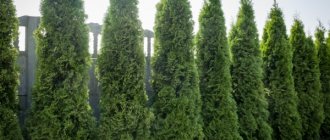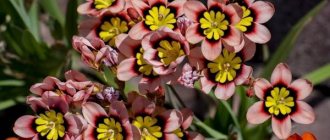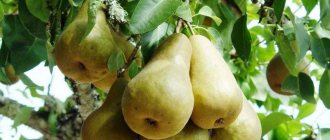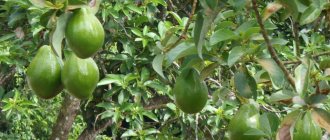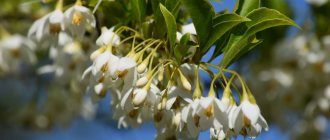Coniferous crops have been used in park landscaping for a very long time and quite widely, one of the main features of which is that their crown remains green throughout the year. At the same time, Thuja Smaragd, which is undemanding in terms of soil quality and lighting, is very popular among landscape designers. Its unusual crown is distinguished by its neat appearance and compactness. This crop retains its decorative appearance in winter and goes well with various flower arrangements.
Features of thuja Smaragd
The western thuja variety Smaragd (Thuja occidentalis Smaragd) belongs to the western thuja species (Thuja occidentalis). Based on it, breeders managed to obtain a large number of hybrids with a variety of needle colors and habit. The standard has moderate annual growth and also has a conical crown. The lifespan of this monoecious crop is from 100 to 130 years and even more.
When the plant reaches the age of 10 years, its height is approximately 250 centimeters. The height of an adult thuja can vary between 400–600 cm. In this case, the crown reaches approximately 100–180 cm in diameter. The average annual growth of a tree is about 10 centimeters, while the diameter of the crown increases by no more than 40–60 millimeters per year.
The crown has a medium density and has a narrow conical shape. Thuja stems are usually weakly branched. The shoots directed upward are located at an acute angle relative to the trunk. While the branches are young, they are covered with shiny bark, while they retain their greenish color all year round.
Some varieties of thuja have such a feature as a change in crown color depending on the season. Thuja Smaragd tolerates formative pruning very well, so the shape of its crown can be made spherical, cylindrical, spiral, etc.
The needles are glossy greenish scaly leaves that usually retain their color regardless of the season. This plant can withstand temperatures down to minus 36 degrees, thanks to which it can be cultivated in open ground in a variety of regions, including the Leningrad and Moscow regions. Full ripening of seeds is observed in late summer or early autumn. They are located in small oblong ovoid cones of brown color, reaching approximately 10 mm in length.
Thuya SMARAGD - The splendor of landscape design.
Choosing a place
The main positive quality of thuja is that it is not too picky about the quality of the soil and the amount of moisture. Meanwhile, the plant is very light-loving. A comfortable place is the guarantee that a healthy and beautiful thuja Smaragd will grow on your site. Planting in the fall is no exception. At this time of year, you should also choose the sunniest area. If you plant a thuja in a shady place, it will grow sparse, which means it will not look so attractive.
Although this plant is unpretentious to soil, it is still worth planting it in well-permeable and fertile soil. A sufficient amount of water will also be a favorable factor. If the soil is too dry, the thuja may turn yellow and crumble.
If you purchased seedlings, be sure to ask when to plant thuja and what its roots are, since some varieties have their own characteristics.
If the planting site is chosen correctly, then virtually no maintenance is required for this evergreen tree.
Thuja varieties Smaragd
Landscape designers in their work often use a variety of hybrids and varieties that were bred using thuja western Smaragd. If desired, the area can be decorated with a relatively tall tapeworm or a low-growing compact variety with an unusual color of needles. The most popular varieties of thuja Smaragd will be described below.
Thuja White Smaragd (Vitbont)
This plant has a very dense crown with a distinctly pointed crown. The height of an adult plant is about 300 cm, and its width is approximately 100 cm. The growth rate of the tree is influenced by the climatic conditions of the region in which it is grown. Thuja grows most slowly in the Moscow region and more northern regions, while in areas located further south, the tree grows more rapidly.
While the bark is young, it is colored brownish-red, but over the years its color changes to brownish-gray. Young shoots in the summer months have a light, almost yellow color, while at the tops they are variegated cream or white. In winter, the shoots turn pale green. The lifespan of small shoots is about 2 or 3 years, after which they fly around. The formation of flowers occurs in the autumn, and they open only in April or May. The cone is about 0.7 cm long and contains a pair of seeds inside. After complete ripening, the cone turns brown.
Thuja Smaragd Variegata
An adult plant has a height of about 500 cm, while its diameter reaches about 180 cm. Over the course of a year, the tree increases in height by about 10 centimeters, and in diameter - up to 4 centimeters. When the tree is ten years old, its height will be approximately 250 cm. The branches are decorated with needles, which are soft, glossy scales of a rich green color, the tips of which are painted almost white. It tolerates formative pruning well, but it is recommended to remove no more than 1/3 of the length of the shoot at a time.
Thuja Smaragd Spotti
The crown of such a plant is highly decorative. The greenish needles are decorated with milky specks, arranged randomly. Thanks to this conical shape, the tree looks more voluminous. This variety looks most decorative when planted together with dark green coniferous plants. The tree reaches a height of 300 cm, while its diameter is no more than 100 cm. Over the course of a year, the tree increases in height by approximately 10 centimeters, and in width by approximately 4 centimeters. This variety is highly shade-tolerant, and it is also very demanding on soil nutrition.
Thuja Smaragd Yellow Ribbon
In this variety, young needles at the beginning of the spring have an orange color, while in the summer they become green-golden, and in late autumn they turn into a darker bronze hue. When the plant is 15 years old, its height will be 200–250 cm and its width will be approximately 80 cm. In 1 year, the height of the tree increases by approximately 12 centimeters, and its width by up to 8 centimeters. The shape of the crown is conical, but it looks more like a teardrop. This plant is highly branched and has a very high density.
Thuja Smaragd. Secrets of easy care.
Varieties of Western thuja
There are several varieties of this crop, which differ in their shape, color palette and foliage density.
Popular types are:
- Golden Smaragd. Conifers of this variety have pleasant yellow-green foliage;
- White emerald. A distinctive feature of this variety is the presence of a white tint at the tips of the crown;
- Smaragd Variegata. The color of conifer foliage combines two shades that harmoniously combine with each other;
- Smaragd spiral. The needles have a spiral shape, which makes the crown thick and voluminous.
Spreading
Western thuja comes from North America, and can be found there in the northern part of the United States and in southeastern Canada. This plant was brought to European countries in the 16th century, after which it began to be widely used to decorate parks and gardens. In Russia, the thuja varieties Smaragd are very popular in culture. They are grown in almost every region, except the southern ones, since there is often prolonged drought, and thuja is quite moisture-loving.
Garden plants are extremely easy to distinguish from wild plants, since they are less tall and their crown has a clearer shape. The plant grows well in the shade, so it easily survives even in dense forest stands. If the seeds fall into an area with moist nutrient soil and a low level of groundwater, they will germinate very quickly.
Care, feeding, protection from cold
For the first 2-3 years, young seedlings are protected from direct sunlight at midday. For shelter, non-woven material that reflects the sun's rays is used. Dark matter is not taken, since a greenhouse effect is created under it, and the plant does not receive enough air.
The Western guest likes moderate humidity. The frequency of irrigation depends on the occurrence of groundwater. If they are close to the surface, then 1-2 waterings per month are sufficient; in other cases, water once a week. During periods of drought, the amount of moisture is increased. 1 tree requires 10 liters of water. Watering is needed even if the soil is covered with mulch.
The tree responds gratefully to sprinkling, but thuja can only be watered in this way in the evening, so that the drops do not evaporate from the sun, leaving burns.
The soil around the seedlings is weeded to remove weeds if it is not mulched. Due to the proximity of the roots to the surface, weeding is carried out manually and extremely carefully, and in cool weather or in the morning. If the soil becomes covered with a hard crust, then it must be loosened so that air can flow freely to the roots.
- Feeding and shelter
Spruce branches as a protective structure
Caring for a young thuja is not complete without feeding. In the first year after planting, the plant will need autumn feeding. To prepare for winter, phosphorus-potassium fertilizers (superphosphate or potassium sulfate) are applied. With the onset of spring, fertilize with any complex for conifers, for example, Kemira. Spring feeding is carried out in two stages with an interval of 2 weeks. Adult conifers are fertilized with humus after a hard winter or if growth problems arise.
In the first years of life, young seedlings require protection from winter cold and spring sun. In autumn, the tree is tied with twine and covered with burlap to protect it from wind and snow. The shelter is removed as soon as the snow melts.
Planting thuja Smaragd
Planting of thuja Smaragd in open ground should be carried out at the beginning of autumn (September) or early spring. Procedure:
- For the planting hole, select an area that will not be located next to a fence, building walls, or large trees. Its depth should be about 0.8 meters and its width up to 1 meter. The plant reacts extremely negatively to drafts, especially young, immature seedlings. It is very important that the selected area is illuminated by the sun for at least several hours during the day.
- Make a good drainage layer about 15 centimeters thick at the bottom of the hole. To do this, use fragments of brick, as well as small crushed stone or gravel.
- The earth that remains after preparing the pit is mixed with 40 grams of superphosphate and 0.5–0.6 kg of wood ash.
- Next, a seedling is taken and placed in a hole so that its root collar rises slightly above the soil level.
- Next, the hole is filled with nutrient soil.
- Cover the tree trunk circle with a layer of mulch: sawdust, mown grass, pine needles, chopped bark, etc.
- After some time, the soil will settle, after which it will need to be added.
If you decide to create a hedge from thuja, then when planting seedlings between them you should leave a distance of 2–5 meters (minimum 0.7 meters), and the distance depends on how large the variety is. After a few years, the hedge will be highly dense.
Thuja Smaragd (Thuja Smaragd) planting, feeding, propagation
Top dressing
Thuja, like all conifers, does not like excess fertilizers, especially nitrogen ones. You should never use mullein, fresh manure, or chicken droppings. From organic matter, only well-aged humus, which is at least 3 years old, is acceptable. You can apply it as mulch in the spring, replacing this completely with fertilizing. Or when planting plants in a planting hole, if the soil is not nutritious enough (peaty or sandy), you can add a bucket of humus to the top layer of soil.
It is better not to use fertilizing for the first two years after planting - the nutrition contained in the soil is sufficient. Do not forget that thuja Smaragd grows slowly, the maximum increase in height is 10 cm per year - and even then, not for every variety. It is impossible and unnecessary to try to accelerate the growth rate with fertilizing.
When the need for nutrition arises, after 2-3 years, it is advisable to use special fertilizers for coniferous crops, or a universal one for deciduous crops with a low dose of nitrogen, where there is more potassium and phosphorus, for example, Kemira-Universal (20 g for a small plant about 1 m tall , 30-40 g for a 1.5-2 m tree and 50-60 g for a full-aged 4-5 m beauty). The frequency of fertilizing is once every 1.5-2 months, i.e. 2-3 times per season, feed the last time at the end of August.
Each fertilizing should be carried out only on damp soil to avoid burning the roots. Dosages of complex fertilizer should not be exceeded.
Caring for thuja Smaragd
Watering
Thuja Smaragd is easy to care for, so even an inexperienced gardener can easily grow it. It needs to be watered only when during the warm season there is hot and dry weather for a long time (at least 7 days). At least one bucket of water is poured under one plant at a time. It is recommended to water in the morning or evening, since wet needles should not be exposed to direct sunlight. In urban environments, it is recommended to regularly sprinkle the crown, which will help remove accumulated dust and maintain the required level of humidity.
Top dressing
The planted thuja Smaragd seedlings are not fed at all for one year. During this time, the tree intensively grows its root system, and it reacts extremely negatively to large amounts of nutrients in the soil. Moreover, starting from the second year, the tree is fed regularly. In the spring, a mineral complex for coniferous plants is added to the tree trunk circle, while in the last summer weeks the surface of the earth is loosened with the addition of compost.
Rules for feeding thuja Smaragd:
- Nitrogen-containing fertilizers are fed only in the spring, since nitrogen is designed to activate the growth of young needles.
- The day before applying fertilizer, water the tree abundantly.
- In the autumn, fertilizing is not carried out, as this can activate the growth of the tree, and at this time it should be preparing for wintering.
Wintering
Until 2 years have passed since the seedling was planted, it should be covered for the winter. This is done in the fall after the temperature at night begins to steadily drop to negative values. To cover the thuja, special “huts” are made from white non-woven material and slats. Thanks to them, fragile branches will be protected from breakage and deformation from icicles, heavy “snow caps,” strong gusts of wind and freezing. With the onset of spring warmth, the shelter should be removed, after which pruning is carried out for sanitary purposes.
How to accelerate growth
The actual rate of growth you will see depends very little on you. In order for it to be maximum, trees need to be provided with a good supply of nutrients and moisture. In this case, be sure to follow the instructions of the variety producer and try not to overuse fertilizers. Since their excess will be harmful to any tree or shrub.
Four main factors influence plant growth:
- light;
- water;
- temperature;
- nutrients.
These four elements influence growth hormones, causing it to grow faster or slower. A change in any of the four factors can cause stress in the plant, which stops or alters growth.
The better developed the root system, the greater the annual growth.
Also keep in mind that the growth rate depends on the roots. A small seedling has a small root system. And if a growth rate of, for example, 5–10 cm is indicated for the annual growth, then under the best conditions it will reach only 5 cm. As it develops, it grows roots and becomes capable of feeding a larger crown.
Reproduction methods
Thuja Smaragd is grown from seeds exclusively in specialized nurseries. The fact is that this process is very complex and lengthy. It takes about five years from the time the seeds are sown until they are planted on the plot.
An easier and faster method of propagation is cuttings. September is best for taking cuttings. They cut off powerful and not diseased branches, the bark of which has not yet become lignified, and take them from the middle of the trunk. The selected branch is torn off along with a small piece of bark (with a “heel”). The cuttings should reach about half a meter in length. It is planted for rooting in a substrate consisting of soil and peat, taken in equal parts. To prevent the needles from drying out, the top of the cutting is covered with a cap, which should be transparent.
For better rooting of the segment, it is provided with a sufficient amount of diffused bright light and an optimal temperature - about 23 degrees. Remove the hood every day to ventilate the cuttings and moisten them from the sprayer. The cuttings are planted in open soil in a permanent place after complete rooting in May (next season).
TUYA - reproduction. The simplest but most effective way to propagate and grow thuja is by cuttings.
Planting and replanting
The soil for growing young thuja should be loose, allowing moisture and air to pass well to the roots of the plant. You can buy it for growing thuja at a flower shop, choosing the composition for coniferous plants. You can cook it yourself. Mix 2 parts coniferous soil, 4 parts leaf soil. Add half a portion of sand.
Containers or pots for dwarf thujas can have a volume of 20-30 liters. For larger plants, you need a 100-150 liter container. In this case, the plants can be left outside for the winter. A pot for planting thuja is 3 times larger than a lump of earth with roots. A drainage layer is placed at the bottom of the pot. It will prevent moisture from stagnating near the root system of the plant. It can be made from pieces of foam plastic or cut corks. You can add gravel, but in this case it will significantly affect the weight of the pot.
Install the thuja so that the root collar is at the level of the top layer of soil. Watered. Install in a fairly bright place, but away from direct sunlight. You can even use northern windows, but the amount of light must be sufficient. Otherwise, the crown will become sparse and ugly.
The thuja is replanted every year during the first years of its life, while increasing the diameter of the pot by several centimeters.
Older thujas need different soil than young plants. Mix 3 parts of peat and one part each of sand and leaf soil. The tree is installed so that the soil level remains the same as before replanting. If you deepen the root collar further, the root may rot. The root system of the thuja is located in the upper part of the soil. Therefore, you cannot loosen it too much, so as not to damage the roots.
Diseases and pests
Some pests and fungal diseases pose the greatest danger to Thuja Smaragd:
- Due to late blight, the needles become pale gray, and the lower part of the trunk also softens . If the disease is at the initial stage, then the tree is watered with fungicidal preparations. If the thuja does not recover, then it is dug up and burned.
- At the beginning of the spring, the shoots may turn brown, which indicates infection with a fungal disease . To help the plant, limestone is added to the soil, and the crown is treated with a solution of Fundazol. All diseased branches should be pruned and destroyed.
- For an adult plant, the appearance of thuja false scale can be disastrous . Because of them, yellow sores form on the bark and spots on the branches. To save the tree, it is treated with a suitable insecticidal preparation or alcohol solution.
Why does thuja turn yellow?
Often, when growing thuja, you have to deal with such a problem as yellowed needles. There can be many reasons, but most often the problem lies in improper care.
Why does the thuja turn yellow:
- The thuja is affected by fungal diseases, due to which the needles turn yellow and the shoots acquire a brown tint. You can save the tree in the following way: cut off all damaged shoots and burn them. Spray the plant itself with fungicides;
- the tree may begin to dry out due to thuja aphids. If you do not start fighting insects in time, they can destroy the tree. Spraying with karbofos will help get rid of the pest;
- Thuja occidentalis often turns yellow due to false scale insects. The first sign is that reddish growths, similar to cones, begin to appear on the needles. The drugs karbofos and rogor are effective in controlling the pest.
Note! Irregular watering, lack of nutrients or drying out of the soil also contribute to yellowing of the needles.
If the needles of a thuja turn yellow, what to do:
- First of all, it is worth analyzing watering. Were there any disturbances in it, did the soil dry out?
- inspect the tree. The cause of yellowing may lie in insects;
- add mineral or organic fertilizers if they have never been added before or added, but rarely.
A quick response to this problem will allow you to deal with it immediately and not lead to the death of the tree.
The needles turn yellow
Thuja Smaragd in landscape design
Thuja Smaragd is a spectacular tree, which, in addition to its external beauty, has great benefits for humans: it helps clean the air from dust and pathogenic microbes, and also saturates it with beneficial phytoncides. There are several methods for planting thuja:
- Creation of hedges . Planting is carried out in 1 or 2 rows. This will help zone the space or outline boundaries.
- Single landings . The crown is given an unusual shape using an artistic haircut.
- Creating a compact group from several varieties of thuja at once . Helps create a picturesque corner in the garden.
Thuja SMARAGD. How to choose thuja?
Description and varieties
Thuja belongs to the cypress family. Another name is ironwood. In natural conditions, which is Japan and North America, it can reach a height of 7 m.
Thuja is an evergreen plant, tree or bush, with more than a hundred decorative forms.
Its branches are flat, its leaves-needles are small diamond-shaped. They are located opposite and cover the branches with peculiar scales. The leaves resemble tiles in shape and placement. They also stack on top of each other to create an intricate path. The cones are bent downwards, oblong in shape.
Young shoots are green. With age, they become woody and turn brown. In place of flower buds, after pollination by anthers, cones are formed. Their size is about 1 cm. They ripen in early autumn. Thuja leaves contain camphor oil. This is due to the pleasant smell that comes from the plant.
Thuja has several types:
Chinese or Sichuan.
Nowadays, oriental thuja is increasingly grown as a potted plant. For this purpose, breeders have created many dwarf forms. They are distinguished by the color of their leaves, which can be green, blue, golden or silver. There are also varieties with mixed colors.
You can grow thuja in pots:
- Danica
- Folded Vipcord
- Folded Kagers Beauty
- Western Golden Globe
- Western Teddy
- Western Miki
- VlostochnayaAurea Nana
- Dwarf
- Teeny Tim
- Little Giant
- Miriam
